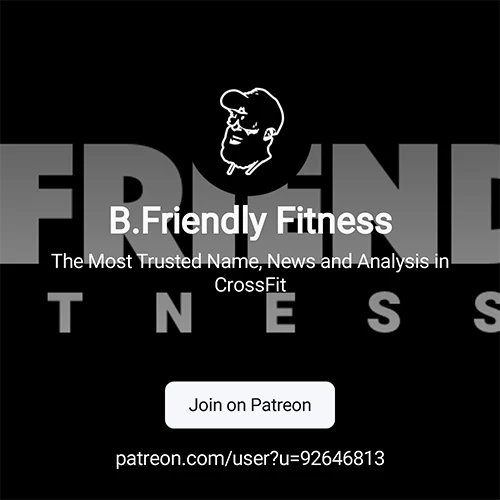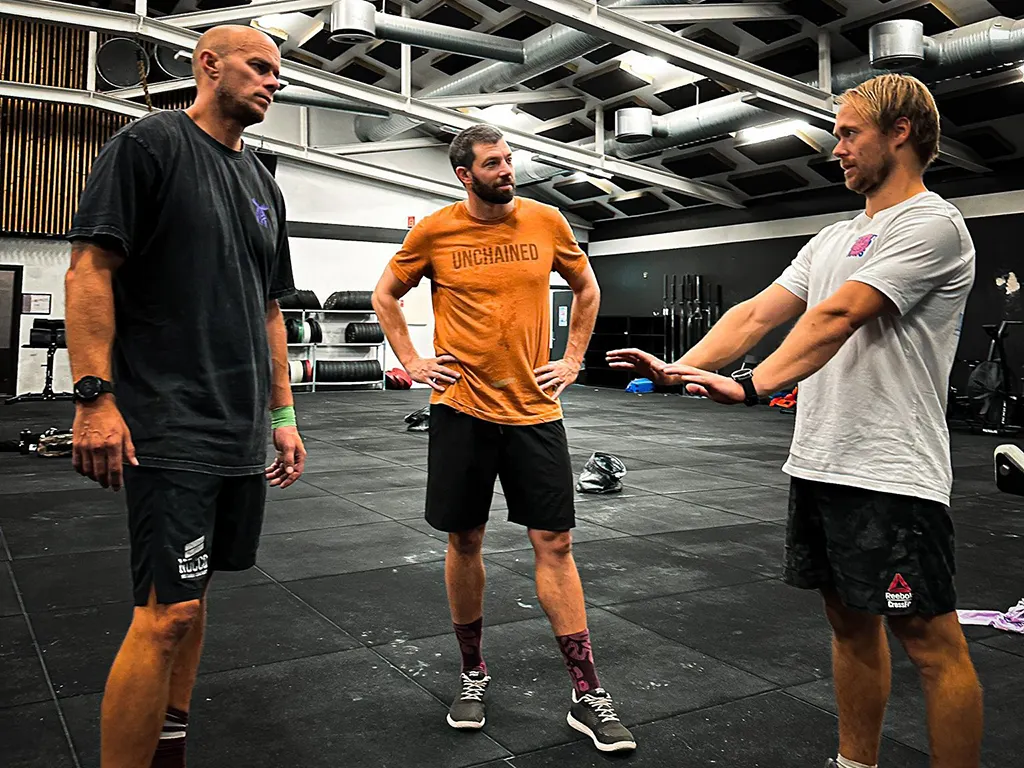Written by Brian Friend
Story Idea and Contributions from: Ryan Tate
Image Credit: Athlete’s Eye
Athletes: Mathew Fraser and Streat Hoerner
If you’ve stumbled upon the sport of CrossFit and you aren’t entirely sure what is happening… This article is for you!
However, even for those who have been watching for a long time, per the words of Greg Glassman (he’s the founder of all of this): “Stick to the basics, and when you feel you’ve mastered them, it’s time to start all over again, this time paying closer attention.” So maybe give this a read anyway.
What is a CrossFIt Competition?
A CrossFit competition is a series of scored events (sometimes called tests) in which a field of athletes compete over a designated period of time.
Athletes’ performances are scored against each other, and based on how well or poorly they did relative to the field, they will be given a corresponding point value, which by the end of the competition will determine the athlete’s final position.
The number of scored events, the scoring system used, and the duration of the competition are variable and unique to each competition.
While that may seem confusing at first, it is important to understand that each competition is designed for a specific group of athletes (or competitors), and therefore, changes in the amount of volume, time between events, and even the scoring system used are likely necessary, and almost always created with the specific group of people competing in mind.
The CrossFit Games Season
If you have seen the CrossFit Games on TV or YouTube, you are watching the best of the best from all around the world. However, that group of athletes started a process of qualifying for the CrossFit Games several months earlier, with the difficulty level of the tasks increasing, and the size of the field decreasing, at each stage, acting as a funnel until the ‘World Championship’ equivalent event (The CrossFit Games) in late summer.
The CrossFit Games season starts with the worldwide Open. Anyone and everyone who wants to be a part of that competition can sign up for it.
The best performing athletes in each division (the top 10%) will advance to a second stage of the season, the Quarterfinals. For all divisions, both the Open and the Quarterfinals are online competitions.
Following Quarterfinals, a specific number of athletes in each division and part of the world will advance to the third and final qualifying stage, the Semifinals. These are held in person for the elite individuals and the elite teams and tend to be your first opportunity to see athletes compete head to head. Age Group athletes Semifinals are online once again.
Finally, based on the performances at Semifinals, the fittest in each division or competitive region will earn qualifying positions to the Games.
Offseason and Local Competitions
While the CrossFit Games season typically starts in February (with the Open) and ends in August (with the Games), there are CrossFit competitions going on all over the world, and all over the place, all year long.
Some offseason competitions are created with the elite athletes in the sport in mind (the Rogue Invitational and the Dubai Fitness Championship for example). Other than the CrossFit Games, these are the most likely competitions for you to stumble upon since they also have a live broadcast that continues to live on YouTube after the fact.
Other competitions are designed to accommodate a huge spectrum of athletes, ranging from elite to beginner, young to old, and even including adaptive communities. The pinnacle example of this has been Wodapalooza. You’ll likely pick up news of these events via social media, with Youtube being a common way to view the events themselves.
However, in local communities, and CrossFit Affiliates everywhere, competitions are always happening. They are designed for their communities, their athletes, their ability or skill level.
What Do Scored Events Consist Of?
In general, CrossFit is looking to test athletes’ work capacity across broad times and modal domains.
In layman’s terms: how good are they at a variety of skills, with a variety of weights, across a variety of ranges of time.
In a traditional competition athletes will need to be strong, have good aerobic conditioning, and be able to move both their bodies through space. These three subsets of skills are commonly referred to as:
- Weightlifting
- Monostructural
- Gymnastics
The idea behind CrossFit competitions is that the best, or fittest, among the group of competing athletes is the one who is on average best at any combination of those three things that is presented to them.
How Do I Know What is Happening During a Live Competition?
This is probably the hardest part about organizing a CrossFit competition because in addition to designing tests which will challenge the athletes, it is also important that the progression of the test is something an audience can understand.
Every competition does this differently based on the space available to them, the budget they have for technology to assist with this, and the venue in which the competition is being presented to its audience (live, online, or both).
Ideally there is something that is moving from one end of the floor to the other which serves as an indicator of who is in the lead. Sometimes it is the athletes themselves which are progressing towards a finish line. Sometimes it is a pylon indicating what round each athlete is on. Sometimes it is an object that is part of the test, like a barbell, or a kettlebell.
In any case, a well designed competition considers this when creating its tests. In some cases, there is a limit to what is possible based on resources, but a competition director can acknowledge that ahead of time if needed to ease any potential frustration from athletes or spectators.
If you are watching on TV or online, it’s possible the broadcast will have a ticker at the top of the screen to show you the progress throughout the event.
One of the most interesting things about watching the sport is seeing how athletes strategise an event, whether that is:
- ‘going unbroken’ (not taking a break for a set of a movement)
- pacing it (holding back a little early, and counting on consistency over time),
- or the fan favorite of ‘going full send’ (giving absolute max effort in the hope that it doesn’t’ backfire).
There is no one standard way to approach an event, and so long as the athlete’s actions are within the prescribed rules for the event, as a viewer you get to see varied approaches to completing a task.
Team Divisions
You may see people competing in teams. During the CrossFit Games season the teams are composed of two men and two women. But in offseason competitions many other team combinations are possible
The tasks they are completing may look largely similar, with some amendments to both test for elements of teamwork, and account for the presence of 4 athletes per lane rather than one.
How Do I Support the Sport of CrossFit?
If you are a fan of the sport of CrossFit, the absolute best thing you can do is get involved. Of course competing is always an option (it’s just a matter of finding the right competition for you), but in many cases it’s better to either volunteer, or simply show up and cheer on the athletes competing.
It does not matter if it’s a small event at a gym in your town, or a large event for some of the top athletes in the world, every competition is improved by a group of passionate volunteers and the support of an excited live audience.
Whether you are new or old when it comes to being a fan of this sport, one of the best things about it is the community. It’s always been that way, and hopefully it always will. If you’ve read this far, you are a part of that community, so go be just that. Volunteer. Go to a live competition. And if you absolutely can’t do either, follow along by watching live online!





What do you think?
Show comments / Leave a comment